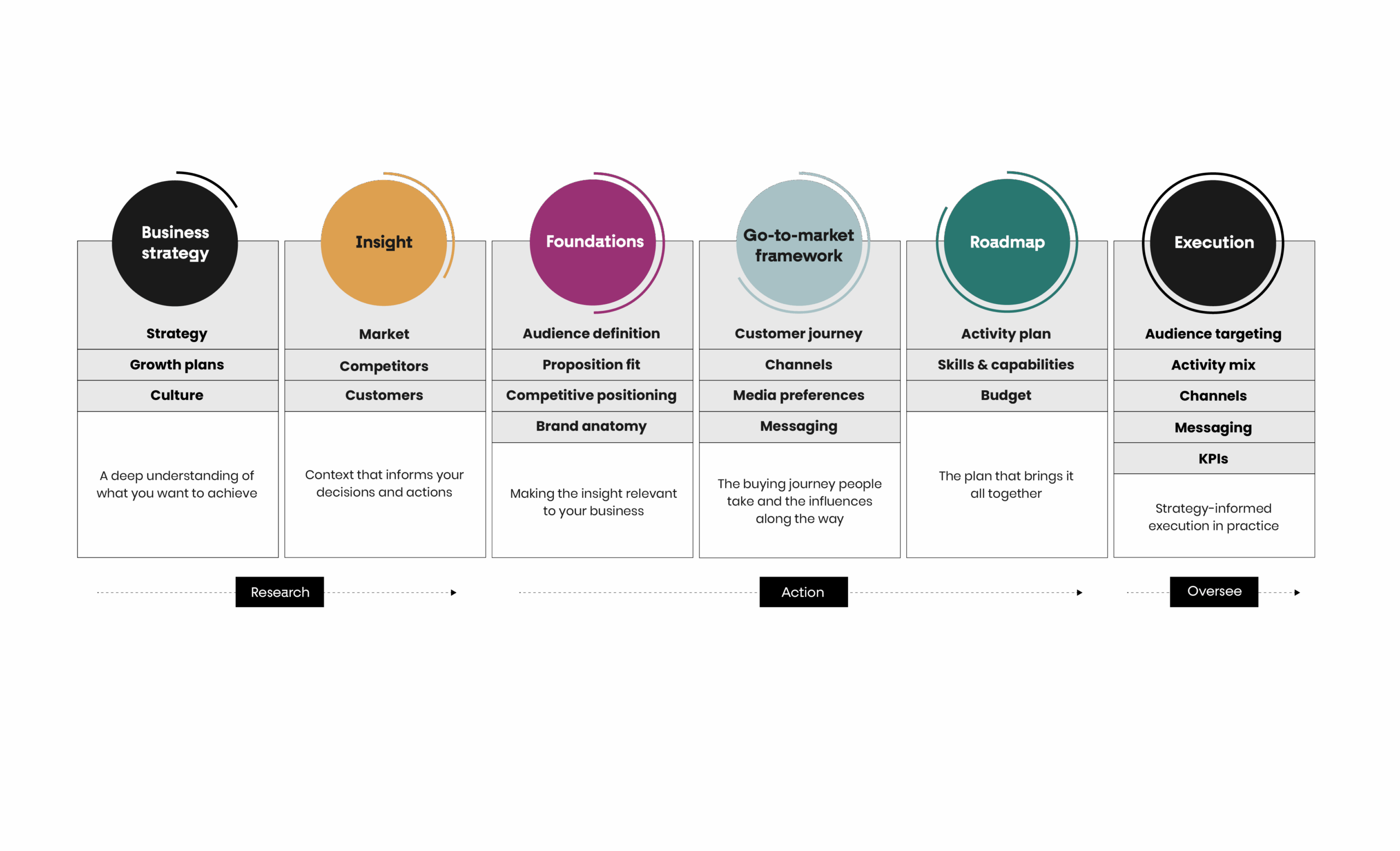This week, sitting round a table with seasoned Founders, MDs and CEOs, (talking about where Boards for SMEs and scale-up businesses should focus their attention), a recurring theme was growth – specifically guiding businesses on taking a long-term and strategic view on growth.
At its core, growth underpins any strong marketing strategy. A good strategy lays the building blocks for sustained progress. Yet “marketing strategy” is a term often used, and misused, in many contexts. So what does it really mean?
A marketing strategy details the routes to winning in your market – how your product or proposition fits a genuine market need, aligned to a clearly defined audience and your business objectives – it sets out the win:win position between customer needs and business goals.
It defines the problems you solve for your audience, the messaging that sets you apart from your competitors, and the touch-points you must actively manage to win customers. It brings structure, ensuring your marketing execution consistently aligns with, and delivers on, your business ambitions.
What is it not? It is not a channel plan, a campaign, a messaging refresh or a copycat playbook. Those are tactics, too often mislabeled as strategy. A true marketing strategy is grounded in a deep understanding and alignment of your business, market and audience.Tactics such as channels, promotions and day to day activity only become effective when executed from clear strategic direction – your marketing strategy.
Before jumping into marketing execution, make sure the right foundations are in place. That way you’ll know your time and money are being well spent!
At Open Velocity, we guide clients through our marketing strategy framework, creating the building blocks needed to ensure your growth is driven by strategy, not just tactics:
Business strategy: we clarify what the business aims to achieve so marketing supports the overall ambition
Insight: we gather market, competitor and customer insight to shape decisions and direction
Marketing foundations: we use these insights to define the core elements of your marketing strategy – audience, proposition fit, competitive positioning – which together inform your brand anatomy (how you present yourself to market)
Go-to-market framework: we map out how to reach your target audience and the levers that influence their decisions to buy
Roadmap: we detail the activity, skills and budget required to activate your strategy
Execution: we oversee the delivery of the day-to-day activity, tracking performance and adapting as needed (learn and adapt)

Strategy-informed execution
After years in the marketing industry, I know we love our own hype. Talking about “strategy” often feels detached from the day-to-day — it lacks excitement and sounds slow. So instead we talk about growth hacking, playbooks, growth loops, revenue marketing, go-to-markets. All valid in their own right, but they’re executional models that only work when guided by strong underlying strategy. Without it, execution risks missing the point.
I’ve lost count of how often I’ve heard recently that “the marketing playbooks are broken”. Much of this stems from conversations about LLMs shaking up the marketing world. Businesses and marketers are busy chasing visibility in the age of AI, but few are stepping back to ask the real question – why are the playbooks broken?
Playbooks succeed when markets are relatively stable, when doing what’s been shown to work is enough. But when conditions shift, you need to change track. That means going back to basics — the strategic foundations of execution. If you’re unsure who you’re talking to, how they behave, or what you need to say to get on their radar, it’s no surprise the playbook stops working.
Customer behaviour is shifting quickly in today’s tech-driven world. Strong marketing discipline circles back to strategy: re-grounding in audience understanding and adapting execution accordingly. We have to embrace new channels and behaviours, but do that in the context of what customers actually want and need from us. Strategy is the key to solving growth problems.
Strategy is first and foremost about finding human connections that drive growth
My final reflection on the importance of marketing strategy was prompted by a podcast I watched this week – one of my former HSBC bosses and an all-round top marketer. It was a timely reminder to always be looking ahead, tracking the changing landscape, but with a constant eye on ‘the rear view mirror’, watching your customers and seeing how they’re reacting to the world around them.
At its heart, marketing is about human connection. Our role as marketers is to connect customers with businesses in ways that create long-term value. That requires execution routed in understanding, insight and empathy. A strong marketing strategy provides the knowledge base that powers this, enabling execution that builds trust and drives sustained growth. Do that well, and even in a world of algorithms and LLMs, you are rewarded with their preference for strong, relevant and trusted brands.

